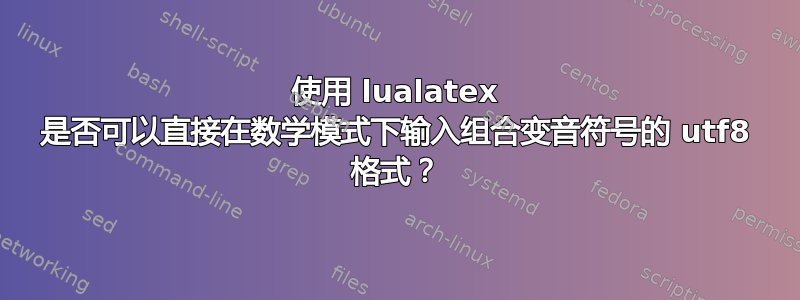
我正在尝试排版一份文档,并在其中直接输入组合变音符号。我使用 LuaLaTex。以下是一个说明原始问题的最小示例:
\documentclass{minimal}
\usepackage{unicode-math}
\setmathfont{XITS Math}
\begin{document}
$v⃗$
\end{document}
上面的矢量箭头 (U+20D7) 在输出中完全丢失。在文本模式下它会显示,但在数学模式下它会从水平列表中完全丢弃。
然后我尝试了以下操作:
\documentclass{minimal}
\usepackage{unicode-math}
\setmathfont{XITS Math}
{
\catcode`\_=11\relax
\catcode`\:=11\relax
\gdef\SetMathCode#1#2{\um_set_mathcode:nnn{#1}{#2}\um_symfont_tl}
}
\SetMathCode{"20D7}\mathaccent
\begin{document}
$v⃗$
\end{document}
此代码本质上是\Umathcode通过 unicode-math 包中的宏间接使用的。原因是,我发现必须将箭头的数学系列更改为 XITS 字体。变音符号(可能还有其他一些字符)的映射不会自动设置为数学模式。
现在箭头排版在重音符号 v 的右侧。我希望它排版为重音符号,位于 v 上方。宏\vec可以\Umathaccent工作,但如果可能的话,我想使公式纯文本可读。(我使用 Emacs quail 系统进行输入。)
您能给我一些建议吗?
我的LuaTeX版本是beta-0.70.2,TeX Live 2012,LaTeX2e <2011/06/27>
XITS 字体是1.105版本。
提前致谢
笔记:
显然,问题出现在强调特殊的类似手写体的字母时。
最后,问题似乎出在特殊顶部重音字形度量的处理上。它应该按照 luatex 手册的“数学重音处理”部分中所述进行,但实际上只针对命令进行\Umathaccent,我认为忘记了组合字符。字体的文本版本使用其他具有水平偏移的机制(称为“方位”?),并绕过了此限制。
我会进一步调查。如果这是核心问题,我应该向 LuaTeX 的人提出这个问题。认为这个问题已经关闭了。无论如何,它变得太具体了。
答案1
我使用 lua 脚本让它工作。您的最小示例如下:
\documentclass{minimal}
\usepackage{unicode-math}
\setmathfont{XITS Math}
\AtBeginDocument{\directlua{require("combining_preprocessor.lua")}}
\newcommand{\⃗}[1]{\ensuremath{\vec{#1}}}
\begin{document}
$v⃗$
\end{document}
这个想法是,让 LaTeX 处理来自后它的参数,这就是 Unicode 组合字符的工作方式,因此我们使用预处理器来移动重音符,使其位于其参数之前。也就是说,在脚本中映射v⃗到,然后定义您想要的任何操作。(这是一个反斜杠,后跟一个组合箭头,应该打印在反斜杠上方。)\⃗{v}\⃗
我的 lua 脚本可以完成大多数(全部?)组合字符,因此您只需要在文件中定义它们应该做什么.tex。同一字符上可以有多个重音。示例:
\documentclass{minimal}
\usepackage{unicode-math}
\setmathfont{XITS Math}
\AtBeginDocument{\directlua{require("combining_preprocessor.lua")}}
\newcommand{\̂}[1]{\ensuremath{\hat{#1}}}
\newcommand{\⃑}[1]{\ensuremath{\vec{#1}}}
\newcommand{\̱}[1]{\ensuremath{\underline{#1}}}
\newcommand{\́}[1]{\ensuremath{\acute{#1}}}
\usepackage{stackrel}
\newcommand{\᷽}[1]{\ensuremath{\stackrel[\approx]{}{#1}}}
\begin{document}
Hello
$ℂ̂$ is hat on $ℂ$, more on $ℂ̂⃑$ (stress test)
$ℂ̂ x̂$
Many combining accents on $x᷽̱̂́⃑$ is cool.
\end{document}
(我的浏览器无法正确显示这里的许多组合字符,但它在 PDF 文件中看起来不错。)
不确定这是否是理想的做事方式,但就其价值而言,情况如下combining_preprocessor.lua:
function minornil(a, b)
if a == nil and b == nil then
return nil
elseif a == nil then
return b
elseif b == nil then
return a
else
return math.min(a, b)
end
end
function findfirstcombining(line, n)
local a = string.find(line, "\204[\128-\191]", n) -- From U0300,
local b = string.find(line, "\205[\128-\175]", n) -- to U036F.
a = minornil(a, b)
b = string.find(line, "\226\131[\144-\176]", n) -- U20D0 to U20F0
a = minornil(a, b)
b = string.find(line, "\225\183[\128-\191]", n) -- U1DC0 to U1DFF
a = minornil(a, b)
return a
end
function is_utf8_continuation(byte)
return byte < 191 and byte > 127
end
function find_next_utf8_char(str, n)
while str:byte(n) ~= nil and is_utf8_continuation(str:byte(n)) do
n = n + 1
end
return n
end
function combining_iter(str)
local n = 0
return function ()
n = (n ~= nil) and findfirstcombining(str, n + 1)
return n
end
end
function dobuffer(line)
local n1 = 0
local t = {}
for n2 in combining_iter(line) do
if n2 > n1 then
local n3 = n2
repeat
n3 = n3 - 1
until not is_utf8_continuation(line:byte(n3))
table.insert(t, string.sub(line, n1, n3 - 1))
n1 = find_next_utf8_char(line, n2 + 1)
local comb = {}
table.insert(comb, "\\" .. string.sub(line, n2, n1 - 1) .. "{")
table.insert(comb, string.sub(line, n3, n2 - 1) .. "}")
n2 = findfirstcombining(line, n1)
while n2 == n1 do
n1 = find_next_utf8_char(line, n2 + 1)
table.insert(comb, 1, "\\" .. line:sub(n2, n1 - 1) .. "{")
table.insert(comb, "}")
n2 = findfirstcombining(line, n1)
end
table.insert(t, table.concat(comb))
end
end
table.insert(t, string.sub(line, n1))
return table.concat(t)
end
luatexbase.add_to_callback("process_input_buffer",
dobuffer, "combining_preprocessor", 1)
答案2
unicode-math没有像设置\mathcode其他 Unicode 字符(例如数学斜体)那样设置 Unicode 重音符号,因此 TeX 在第一个数学字体中寻找它们,该字体是 Computer Modern Math Italic(cmmi10在日志中),它没有重音符号(至少在 Unicode 位置上没有)。
但即使unicode-math设置了,\mathcode数学重音也不会被正确定位(正如您已经注意到的),因为必须使用\(U|XeTeX)mathaacent原始重音调用重音才能让 TeX 发挥其数学重音定位魔法。
可能可以将重音变成活动的数学字符并将它们映射到相应的宏(unicode-math已经做了这种棘手的事情以允许直接输入其他 Unicode 字符),但这留给读者练习(阅读:我不知道如何做到这一点,上次我试图理解那段代码时,我几乎失去理智了)。
引擎本身对 Unicode 字符一无所知,用户(或宏包编写者)有责任使用适当的原始和/或数学代码来告诉它哪个字符应被视为重音符号、大运算符或开符号等(否则事情会非常不灵活)。


